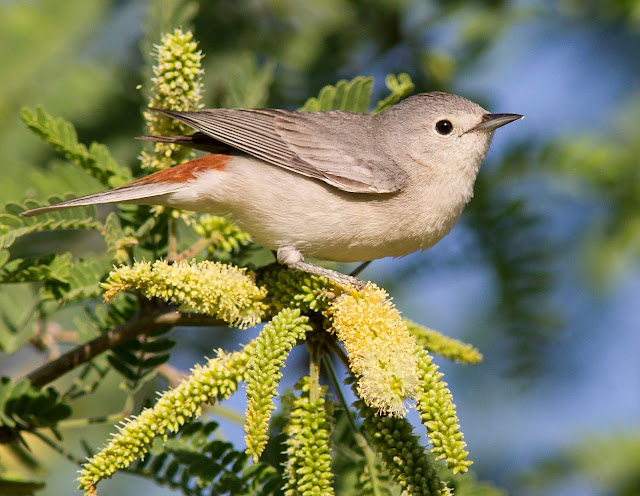Mesquite Bosques & the Lucy’s Warbler
By Ethan Myerson

Lucy's Warbler on velvet mesquite flower, Joan Gellatly
One of the most important and perhaps least known landscapes here in the Sonoran Desert is the mesquite bosque. Even those who have lived in Tucson for years may have never heard the word bosque, but if you’ve ever hiked through one of the riparian areas in our region, you may have found yourself in the midst of one of these unique habitats.
Derived from the Spanish word for “Forest”, a bosque is a stand of trees–often cottonwoods, desert willows and mesquites–found along a riparian (river) corridor, forming a dense, closed-canopy forest. With the reduction in groundwater levels in recent decades, many rivers in the region no longer flow as far as they once did and no longer flood onto their floodplains. This has caused a drastic decrease in mesquite bosques. The fact that mesquite wood has become so valuable in recent years has also led to both dwindling numbers and size of healthy bosque habitat. Before human activity diminished the prominence of these bosques, some of them stretched eight to ten miles long and three or more miles wide, providing lush cover, cool shade, and plentiful food for a variety of desert species. They were a true oasis, providing a dense, cool reprieve from the desert heat.
.jpg) |
| The mesquites in this bosque are just starting to leaf out and will provide a shady oasis, Olya Weekley |
Even though they are not as plentiful or majestic as they were in the past, these bosques remain important to so many species. If you spend a morning exploring the bosques on the San Pedro and Santa Cruz Rivers, or Tanque Verde Wash, you will likely encounter a number of vertebrate and invertebrate species, as well as a wide variety of plantlife.
The main species of mesquite you’ll see in the bosques of our region is the velvet mesquite, the same species you may see in homes and neighborhoods in Tucson. Mexican elderberry and groves of netleaf hackberry are often found interspersed among the mesquites as well. Grasses such as feather finger grass, plains bristlegrass, and tanglehead can be found on the bosque floor.
Among the invertebrates who make a home in bosques are the colossal and colorful Giant Mesquite Bugs and the flightless and fearsome-looking Longhorn Beetle. Bruchid beetles live in bosques so that they can lay their eggs on mesquite beans. The beetle larvae will bore into and feed on mesquite seeds until they are mature, at which point they eat their way out of the pods.
The vertebrate bosque-dwellers are even more exciting. The largest colony of mesquite mice, one of the rarest native mice in the United States, was believed to exist in a giant mesquite bosque near Tucson. Javelina, deer, and coyotes can all find food and shelter in these riparian havens.
Bosque habitat houses a number of bird species, such as Bell's Vireo, Bewick's Wren, and Blue Grosbeak, and in nearby cottonwood riparian forest, Black Phoebe, Common Yellowthroat, and Willow Flycatcher. Though today’s smaller bosques mean smaller bird populations, a patient and observant nature lover may still be able to see these and other bird species in the remaining bosque habitats.
No discussion of mesquite bosques would be complete, though, without mentioning the Lucy’s Warbler. They’re so linked to mesquites, in fact, that they’re often known as the mesquite warbler. These tiny, whitish-gray birds are cavity nesters, making their homes in natural holes in mesquite trees, or those created and left behind by woodpeckers. Because their diet consists mostly of insects, their first choice for mesquite trees are those near water, making mesquite bosques the perfect neighborhood! Lucy’s Warblers are now known to make use of human-crafted nestboxes thanks to research conducted by Tucson Audubon Society. It was found that the birds prefer nestboxes that have a unique, triangle-shaped design that mimics the shaggy bark of a mesquite tree. If you want to attract Lucy’s Warblers to your yard, nestboxes of this design are available from Tucson Audubon, as are woodworking plans if you want to try to construct your own. Learn more at tucsonaudubon.org/lucys-warbler.
%20Full%20Size%20by%20Paula%20Redinger.jpg) |
| Lucy's Warbler adult and nestlings in a Tucson Audubon nestbox, Paula Redinger |
Visitors to the Sonoran Desert are often surprised to find the landscape to be greener than they expected. One of the features that makes our region so lush and vibrant is the riparian mesquite bosque. Though human activity has impacted the grandeur of the bosques, they remain a vital component of our ecosystem; one that commands our attention and deserves our care.
Ethan Myerson is Director of Development & Communications at Tucson Audubon.

Comments
Post a Comment
Thanks, we value your opinions! Your comment will be reviewed before being published.